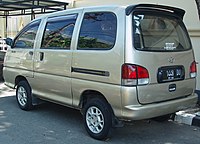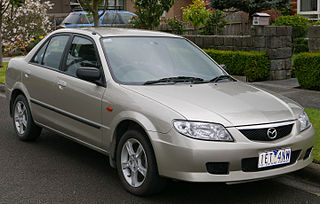
The Mazda Familia, also marketed prominently as the Mazda 323, Mazda Protegé and Mazda Allegro, is a small family car that was manufactured by Mazda between 1963 and 2003. The Familia line was replaced by the Mazda3/Axela for 2004.

Ford Courier is a model nameplate used by Ford since the early 1950s. The Courier moniker has been used on a variety of vehicles all around the world since it was first used in North America for a sedan delivery. The Courier nameplate was also used by Ford for a series of compact pickup trucks and would also see use by Ford of Europe denoting a Fiesta-based panel van. Ford Brazil used the nameplate for a Fiesta-based coupe utility pickup marketed across Latin America.

The Daihatsu Charade is a supermini car produced by the Japanese manufacturer Daihatsu from 1977 to 2000. It is considered by Daihatsu as a "large compact" or "supermini" car, to differentiate it from the smaller kei car compacts in its line-up, such as the Daihatsu Mira. In Japan, it offers buyers more interior space and a larger engine that allows for the car to also be used outside of urban areas. It replaced the Daihatsu Consorte, although the Charmant took over from the bigger-engined Consortes, and didn't share a platform with a Toyota product.
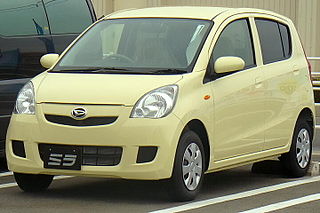
The Daihatsu Mira is a kei car and city car built by Japanese car maker Daihatsu. It has a variety of options and chassis variations, with the latest variant having four models: Mira, Mira AVY, Mira Gino, and Mira VAN. The Mira is the latest successor to the line of cars begun with the Daihatsu Fellow of 1966, and was originally introduced as the commercial version of the Cuore. Outside of Japan, the Mira has also been offered with larger 850 or 1000-cc engines. In Australia, the two-seater version was marketed as the Daihatsu Handivan and later as the Daihatsu Handi. The term mira is Latin meaning "goal" or "purpose".

The Daihatsu Terios is a mini SUV produced by the Japanese automobile manufacturer Daihatsu since 1997 as the successor to the F300 series Rocky. It was initially offered in both short- and long-wheelbase configurations before the former stopped production in 2016 to be replaced by the A200 series Rocky crossover in 2019. The long-wheelbase variant is available mainly for the Indonesian market with three-row seating options. A smaller kei car model called the Terios Kid/Lucia was also available for the first-generation model.

The Toyota Avanza and Daihatsu Xenia are a series of multi-purpose vehicles (MPV) developed by Daihatsu and marketed by both Toyota and Daihatsu, mainly sold with three-row seating. The Avanza and Xenia were developed as an entry-level MPV marketed mainly for the Indonesian and other emerging markets, and mainly produced in Indonesia by Astra Daihatsu Motor. Avanza's spiritual predecessor was the Kijang, whose model program has since been split into two different models to expand Toyota's reach in the MPV sector.

The Daihatsu Hijet is a cab over microvan and kei truck produced and sold by the Japanese automaker Daihatsu since 1960. Despite the similarities between the Hijet name and Toyota's naming scheme for its trucks and vans, the name "Hijet" has been in use for Daihatsu's kei trucks and microvans since 1960, over two decades before Toyota took control. "Hijet", when transliterated into Japanese, is very similar to "Midget", one of Daihatsu's other mini-trucks. According to Daihatsu, the name "Hijet" was created to imply that the vehicle offers higher performance than the Midget. The Hijet competes in Japan with the Honda Acty, Mitsubishi Minicab, Nissan Clipper, Subaru Sambar and Suzuki Carry.

The Daihatsu Applause is a compact car manufactured by the Japanese automaker Daihatsu for British and Australian markets. The Daihatsu Applause was manufactured from 1989 to 2000. It is most notable for its unusual body style, which, despite appearing to be a 4-door notchback sedan, is in fact a 5-door liftback with a notchback-shaped 412-litre trunk and a tailgate.

The Subaru Sambar is a cabover truck and microvan manufactured and marketed by Subaru as Japan's first truck compliant with the country's strict Keitora (軽トラ) or Kei vehicle tax class. Introduced in 1961 in microvan and Kei pickup configurations, the Sambar remains in production, now in its eighth generation — beginning with the sixth generation as a rebadged Daihatsu Hijet.

The Daihatsu Rugger is an off-road vehicle built by Daihatsu between 1984 and 2002. The Rugger was also called the Rocky in most export markets, and Fourtrak in the United Kingdom. It has also received a series of different names elsewhere, which is why it is often referred to by its model designation to distinguish it from its various siblings. In Japan and the US, the Rocky name refers to the smaller F300 series of Daihatsu vehicles.

The Mitsubishi Minicab is a kei truck and microvan, built and sold in Japan by Japanese automaker Mitsubishi Motors since 1966. In Japan, it was sold at a specific retail chain called Galant Shop. It was also sold by China Motor Corporation (CMC) in Taiwan as the CMC Veryca, starting in 1985. A battery electric model of the Minicab, called the Minicab MiEV, is sold in the Japanese market since December 2011.
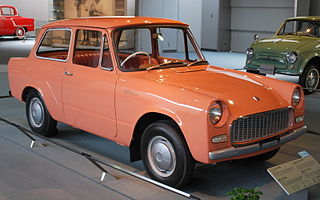
The Toyota Publica is a small car manufactured by the Japanese company Toyota from 1961 until 1978. Conceived as a family car to fulfill the requirements of the Japanese Government's "national car concept", it was the smallest Toyota car during that period and was superseded in that role by the Toyota Starlet, which itself started out as a version of the Publica. It was available as a 2-door vehicle only, but in a selection of body styles, ranging from the base sedan through a station wagon, convertible, coupé and even a coupe utility (pickup), which outlived the other models by a decade, and spawned other models, such as the Toyota Sports 800 and the Toyota MiniAce.

The Suzuki Carry is a kei truck produced by the Japanese automaker Suzuki. The microvan version was originally called the Carry van until 1982 when the passenger van versions were renamed as the Suzuki Every. In Japan, the Carry and Every are kei cars but the Suzuki Every Plus, the bigger version of Every, had a longer bonnet for safety purposes and a larger 1.3-liter 86-hp (63 kW) four-cylinder engine. They have been sold under myriad different names in several countries, including those with Chevrolet and Ford badges.

The Isuzu Faster is a pickup truck that was manufactured and marketed by Isuzu between 1972 and 2002 over three generations. The Faster was succeeded worldwide by Isuzu D-Max, except in Japan and North America.
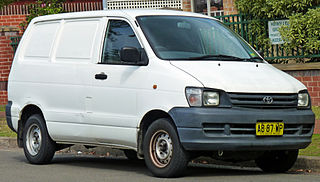
The Toyota LiteAce and TownAce are a line of light commercial and derivative passenger vans produced by the Japanese car manufacturer Toyota. These vehicles originally utilized the cab-over-engine configuration, although since 1996 a semi-cab-over arrangement has featured instead. The LiteAce launched in 1970 as light-duty truck, with commercial and van/wagon body variants added in 1971. In 1976, Toyota released the larger TownAce van/wagon that derived from the LiteAce; a TownAce truck arrived later in 1978. Between 1982 and 1992, the series accommodated the MasterAce Surf—an upscale TownAce passenger wagon.

The Piaggio Porter is a cab over microvan and pick-up produced and sold by the Italian company Piaggio since 1992 under the Piaggio Commercial Vehicle brand.

The Daihatsu Gran Max is a series of light commercial vehicles produced and sold by the Japanese automaker Daihatsu since late 2007. It is also rebadged and marketed by Toyota as the Toyota LiteAce and Toyota TownAce since 2008, and by Mazda in Japan as the Mazda Bongo since 2020.

The Daihatsu Ayla is a city car designed by Daihatsu and manufactured by Astra Daihatsu Motor in Indonesia since 2013, primarily developed for emerging markets. The Ayla has also been sold by Toyota as the Toyota Agya in Indonesia, South Africa, Tunisia and Americas, and the Toyota Wigo in the Philippines, Sri Lanka, Brunei and Vietnam through an OEM agreement. The car is also slightly reengineered and manufactured in Malaysia by Perodua as the Perodua Axia.

The DFSK C-Series is a series of light commercial vehicles manufactured by the Chinese automaker DFSK Motor, a joint venture between Dongfeng Motor and Sokon Industry. The van models were first unveiled on September 21, 2009, whereas the pickup truck models were launched later. The van is available in three different models, the C35, the C36, and the C37. While the pickup is available in four different models, the single cab models are being the C31 and C51, while the double cab models were the C32 and C52.
The Daihatsu H-series engine is a range of four-stroke four-cylinder, internal combustion piston engines, designed by Daihatsu, which is a subsidiary of Toyota. These engines were produced from 1987 through 2009. Ranging from 1.3 L up to 1.6 L, these four-cylinder engines were built with lightness in mind, featuring a hollow crankshaft and camshaft, and the weight of a four-cylinder engine is similar to the 1.0 L three-cylinder CB engines. The H-series engine has aluminium engine blocks and cylinder heads, timing belt driven heads, water-cooled engine cooling system, equipped with both carburetors and Multi-Point Fuel Injection and only available in 16-valve SOHC design.





